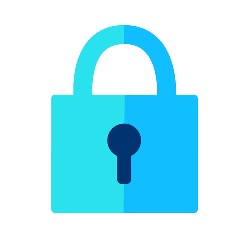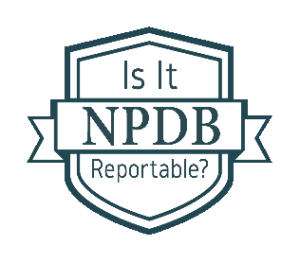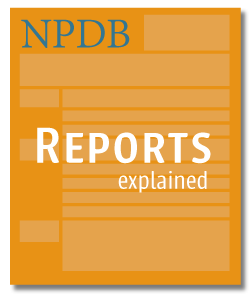NPDB Insights - October 2024
Register Now for the NPDB 101 Webinar
Join us Exit Image on November 19, 2024, from 2:00 to 3:30 p.m., for a general overview of the National Practitioner Data Bank. This webinar will cover querying, reporting, and administrative topics. The agenda includes time at the end for audience members to ask questions.
on November 19, 2024, from 2:00 to 3:30 p.m., for a general overview of the National Practitioner Data Bank. This webinar will cover querying, reporting, and administrative topics. The agenda includes time at the end for audience members to ask questions.
The webinar is for new NPDB users or those seeking a refresher. After the webinar, attendees will be able to:
- Define the purpose of the NPDB
- Describe the types of reports and when to report
- Compare and contrast the features of Continuous Query, One-Time Query, and Self-Query
- Identify NPDB resources available to users
Attendees of the live webinar can request 1.0 NAMSS-approved Continuing Education (CE) credit. Please request the CE credit when registering for the event. NAMSS certificates will be sent out 1–2 weeks after the webinar.
Please register Exit Image in advance if you wish to join us.
in advance if you wish to join us.

Fee Change for Mailed Self-Queries
On Tuesday, October 1, 2024, the supplemental fee for those requesting a mailed paper copy of their Self-Query results increased from $3.00 to $13.00. Mailed copies can only be sent using U.S. Postal Service certified mail, and the increased fee will cover this cost.
The fee for a digitally certified Self-Query remains $3.00. If you rely on applicants and licensees submitting Self-Query responses, we recommend accepting digitally certified Self-Query responses instead of mailed paper copies. Digitally certified PDFs, when viewed with the latest free version of Adobe Acrobat Reader, will display a certification that the file has not been altered. If the content has been altered, an error message will appear. Printed and mailed copies of Self-Query responses are not certified.
To ensure the best querying experience, the NPDB encourages all eligible entities, including state licensing boards, to enroll their practitioners in CQ monitoring. With Continuous Query, you will receive email notifications within 24 hours of a report received by the NPDB. This will help keep you informed about your enrolled practitioners.

Is It Reportable?
A state licensing board submitted a report to the NPDB 6 months ago, after the board placed a practitioner's license on probation. Three months ago, the board reinstated the license. The report in the NPDB still indicates that the license is on probation. Should the board update the information in the NPDB now that the licensure action's status has changed?
Yes. Entities that submit an Initial Report to the NPDB also must report any subsequent revision to the underlying action. The state licensing board, therefore, is required to submit a Revision-to-Action Report after reinstating the license. If, however, the initial action to place the license on probation included an automatic reinstatement of the license that was indicated on the Initial Report, the board is not required to submit a Revision-to-Action Report.

Dear NPDB
When do I need to submit a Revision-to-Action Report?
A Revision-to-Action Report is a report of an additional or continuing action that modifies an adverse action previously reported to the NPDB. An entity that reports an initial adverse action must also report any modification of that action.
Examples of when a Revision-to-Action should be submitted include:
- When clinical privileges, professional society membership, accreditation, program participation, or a license has been reinstated
- When additional sanctions have been taken against the subject of a report based on a previously reported incident
- When the length of an action has been extended or reduced
What's the Difference Between a Revision-to-Action and a Correction?
A Revision-to-Action does not replace the preceding report. Rather, it is treated as a separate action that pertains to the previous action and becomes an additional part of the disclosable record.
A Correction Report fixes erroneous or incomplete information and replaces the original report. This means the original report is no longer part of the disclosable record, and only the Correction Report is. (However, it should be noted that Revisions-to-Action may be required following a correction to an original report. Likewise, Revisions-to-Action may also be corrected when needed.) A Correction Report must be submitted as soon as possible after a reporting entity discovers an error or omission in a report (for example, an incorrect or missing date of birth for the subject of a report). Correction Reports can be submitted as often as needed.
What About Voids?
A Void Report removes the report from the subject's disclosable record. A reporting entity may void a report for the following reasons:
- The report was submitted in error
- The action was not reportable because it did not meet NPDB reporting requirements, such as a reduction in length of a clinical privileges action to 30 days or fewer
- The action was overturned on appeal
When the NPDB processes a Void or a Correction, the reporting entity recieves a confirmation. The NPDB also sends a notification to the subject and to all queriers who received the previous version of the report within the past 3 years. All queriers who received the previous version of the report within the past 3 years are directed to destroy the prior report and any copies of it.
Consult our Reporting to the NPDB page or the Types of Reports section of the NPDB Guidebook for additional information on reporting.
The latest updates and resources are available at https://www.npdb.hrsa.gov.
Previous editions of NPDB Insights are available in our archive.
 An official website of the United States government.
An official website of the United States government.

